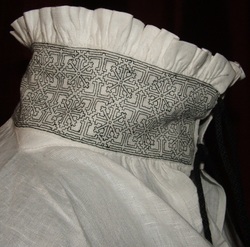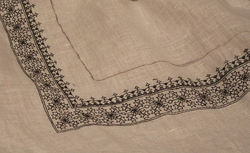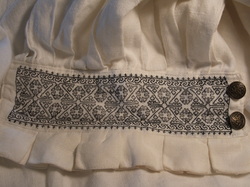16th Century Blackwork
Below are some of my blackwork projects.
Major Projects
Escarbuncles and Crosses

The garment this counted blackwork decorates is a mid-16th century English Tudor men's shirt.
The blackwork pattern is an original design based on a repeating geometric border design found in a 1524 modelbook (Ein New Modelbuch, Johan Schonsperger).
Materials used in this project include handkerchief-weight linen (64 count) and YLI black silk embroidery floss.
Embroidery was completed using a fully-reversible double-running stitch ("Holbein" or "Spanish" stitch).
A chart for this pattern can be found HERE.
The documentation for this project can be found HERE.
Click on the title for pictures!
The blackwork pattern is an original design based on a repeating geometric border design found in a 1524 modelbook (Ein New Modelbuch, Johan Schonsperger).
Materials used in this project include handkerchief-weight linen (64 count) and YLI black silk embroidery floss.
Embroidery was completed using a fully-reversible double-running stitch ("Holbein" or "Spanish" stitch).
A chart for this pattern can be found HERE.
The documentation for this project can be found HERE.
Click on the title for pictures!
Quatrefoils

The garment this counted blackwork decorates is a mid-16th century English Tudor ladies' square necked chemise.
The blackwork pattern was charted by Paula Katherine Marmor at Blackwork Archives, and is based on geometric border patterns of the early 16th century.
Materials used in this project include handkerchief-weight linen (64 count) and YLI black silk embroidery floss.
Embroidery was completed using a fully-reversible double-running stitch ("Holbein" or "Spanish" stitch).
A chart for this pattern can be found HERE.
Click on the title for pictures!
The blackwork pattern was charted by Paula Katherine Marmor at Blackwork Archives, and is based on geometric border patterns of the early 16th century.
Materials used in this project include handkerchief-weight linen (64 count) and YLI black silk embroidery floss.
Embroidery was completed using a fully-reversible double-running stitch ("Holbein" or "Spanish" stitch).
A chart for this pattern can be found HERE.
Click on the title for pictures!
Seymour Border

_The garment this counted blackwork decorates is a mid-16th century English Tudor men's shirt.
The blackwork pattern is charted directly from the famous "Seymour cuffs" (portrait of Jane Seymour completed by Hans Holbein, 1537).
Materials used in this project include handkerchief-weight linen (64 count) and YLI black silk embroidery floss.
Embroidery was completed using a fully-reversible double-running stitch ("Holbein" or "Spanish" stitch).
A chart for this pattern can be found HERE.
Click on the title for pictures!
The blackwork pattern is charted directly from the famous "Seymour cuffs" (portrait of Jane Seymour completed by Hans Holbein, 1537).
Materials used in this project include handkerchief-weight linen (64 count) and YLI black silk embroidery floss.
Embroidery was completed using a fully-reversible double-running stitch ("Holbein" or "Spanish" stitch).
A chart for this pattern can be found HERE.
Click on the title for pictures!
Classes Taught
Basic Counted Blackwork
This class is designed to provide a basic introduction to the art of 16th century counted blackwork. It includes a brief overview of portraiture, a discussion of materials, and a basic tutorial of the double-running stitch technique. Click on the title to see the handout for this class.
